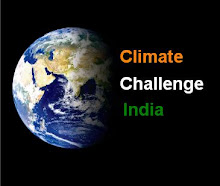Last week, I was unable to post a blog. I was blogged down ... what? Oh! Okay. I was bogged down with preparations for the first workshop for students. It was on climate change. Perhaps you would like to have such workshops too. If yes, contact me.
In my previous blog posting, I had said that I would talk about the impacts of climate change in India. So, that's exactly what I will try to do now.
I say "try" because no one knows for sure exactly how things will go. This is due to two reasons: (a) climate change science, though very strong, is still unable to predict the future of climate with great precision. But, alarmingly, we do see that whatever it HAD predicted, was much less than what has turned out to be the truth. So, if anything, things have appeared to be WORSE than what the science had told us before. The science is improving, however and gives us dire warning. (b) Even less predictable than Earth's climate system is human behaviour. We are capable of adjusting to change, reducing (i.e., mitigating) the impact of the change, and so on. Just as much as we have been good at creating the problems in the first place!
Keeping these in mind, here are some things that we should think about these examples . . .
Threat to livelihoods
With global climate change comes changes in local climatic patterns. This means the already erratic rainfall will become much more so. Undependable! This means agriculture will suffer. Particularly hit will be the poorer farmers, who are a huge proportion of farmers in our country. If the rains are not on time (or don't come at all!), their crops will suffer. With lower production, their income will drop. Debts will increase. We have seen a very sad history of farmer suicides because of the burden of debt. This is a real threat under climate change as well.
As food production suffers, food prices will go up and food will become scarce. This, of course, hits the poorest people the most. It does not spare the wealthier people -- they just get a little more time, that's all.
As sea levels rise, coastal populations will be affected as fisheries, their important livelihood, will suffer. Crops growing near coastal areas will suffer because of salt water seeping into the ground and water supply (it is called "salt water incursion").
All these mean that the various economic activities from food production to manufacturing to services will all suffer from what are called "ripple" or "knock-on" effects -- one thing leading to another and another and so on.
Public health
As climate changes, seasonal temperatures and moisture change. With these, illnesses that are seasonal will last longer. New kinds of disease organisms are likely as well. Many of hese diseases are contagious. For all these, new treatments have to be found and made available. Again, the poor people suffer the most. More preventive measures will be needed.
Threat to life
Rising sea levels threaten people living in coastal areas. But that is not the only threat. Severe weather events (typhoons, droughts, excessive rainfall, heat waves, etc.) will threaten life. Not just human life! Whole ecosystems will be threatened, damaged, and lost forever.
Why should we care about ecosystems? Well, if for no other reason, our survival depends on a healthy ecosystem. In case we have forgotten, we are only a part of the world's ecosystems. As it happens, we may also be the most destructive part!! Damage or loss of ecosystems will mean loss of valuable medicinal plants, valuable sources of food, etc. So, all life is threatened by climate change, not just us! And we depend on other life-forms. So, at least for selfish reasons we should care.
And there are many more threats ... known and as yet unkown ... The bells, they are tolling!
"Oh, NO! Are we doomed then? Is this the beginning of The End?? Should I say goodbye to all my friends, family, and pets?", you ask?
Ummm ... not quite!
"What do you mean?", you ask?
I'll explain next time.
Shabhaash, India!
"Sustainable" living is not just a vague idea of being eco-friendly. It is very practicable.
Navadarshanam is more than a farm, it's an organic haven.
110 acres of forested land that was made barren by human folly has been restored by human wisdom.
So, this week, I salute them for their climate-affirmative efforts.
Go and visit them! You will come away a lot richer!
Go and visit them! You will come away a lot richer!


No comments:
Post a Comment